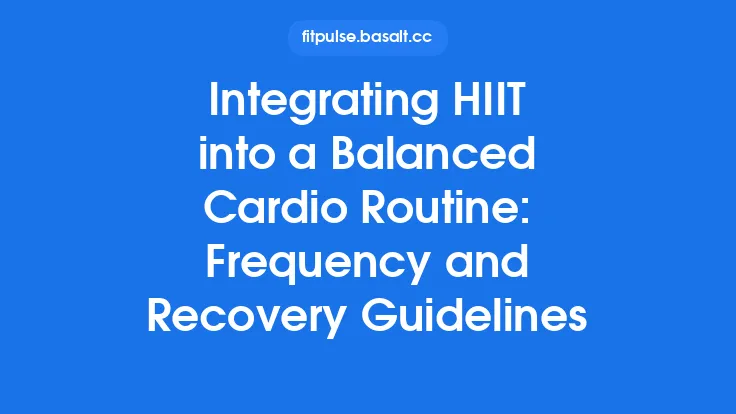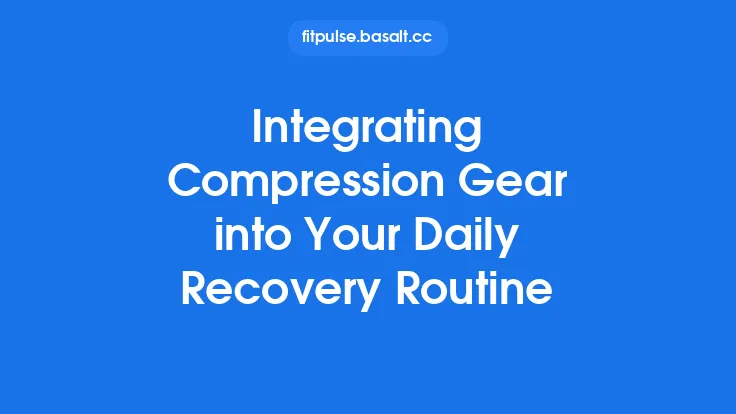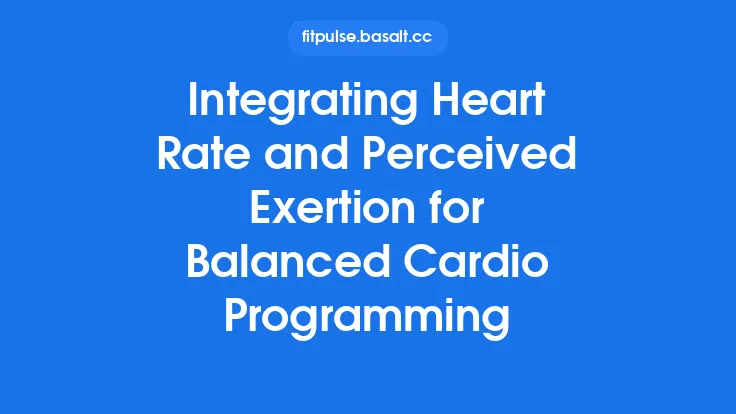Cardio training is a powerful tool for improving cardiovascular health, boosting endurance, and supporting a wide range of fitness goals. Yet, the very qualities that make cardio so effective—repeated stress on the heart, lungs, and muscles—also create a need for systematic recovery. Integrating dedicated recovery weeks into your cardio programming is not an optional luxury; it is a science‑backed strategy that safeguards performance, reduces injury risk, and ultimately accelerates long‑term progress.
In this article we’ll explore the physiological rationale for recovery weeks, identify the signs that tell you a break is needed, outline practical ways to structure those weeks, and provide tools for monitoring how well you’re bouncing back. By the end, you’ll have a clear, actionable framework for weaving recovery into any cardio regimen—whether you’re a recreational runner, a cyclist, a high‑intensity interval training (HIIT) enthusiast, or anyone in between.
Why Recovery Weeks Matter: The Physiology Behind the Pause
1. Muscular and Metabolic Repair
During cardio sessions, especially those that push you into higher intensity zones, muscle fibers experience micro‑damage and glycogen stores are depleted. Recovery weeks give the body the time it needs to:
- Resynthesize glycogen in skeletal muscle and liver, restoring the primary fuel for future workouts.
- Repair micro‑tears in muscle tissue, which, when healed, become stronger and more efficient.
- Clear metabolic by‑products such as lactate and hydrogen ions, reducing the lingering sensation of “burn” and improving subsequent performance.
2. Cardiovascular Adaptations
Repeated cardio stress stimulates beneficial changes in heart size, stroke volume, and capillary density. However, these adaptations plateau—or even regress—if the cardiovascular system is constantly overloaded. A recovery week:
- Allows heart rate variability (HRV) to rise, indicating a balanced autonomic nervous system.
- Promotes endothelial function recovery, supporting better blood flow and oxygen delivery.
3. Hormonal Balance
Intense cardio elevates cortisol (the stress hormone) and can suppress testosterone and growth hormone if not countered with adequate rest. A strategically placed low‑stress week helps:
- Normalize cortisol levels, preventing chronic catabolism.
- Re‑establish anabolic hormone production, which is essential for muscle repair and overall energy.
4. Neurological Reset
The central nervous system (CNS) coordinates the recruitment of motor units during cardio. Over time, CNS fatigue can manifest as reduced coordination, slower reaction times, and a feeling of mental “fog.” Recovery weeks give the CNS a chance to:
- Re‑calibrate motor patterns, improving efficiency.
- Reduce perceived exertion, making future sessions feel easier.
Recognizing When a Recovery Week Is Needed
Even the most disciplined athletes can overlook subtle warning signs. Below are objective and subjective cues that suggest it’s time to dial back the intensity:
| Objective Metric | What It Indicates |
|---|---|
| Resting HRV ↓ > 10% from baseline | Autonomic imbalance, elevated stress |
| Resting heart rate ↑ > 5 bpm | Incomplete recovery, possible overreaching |
| Training impulse (TRIMP) accumulation > 2,000–2,500 AU over 2 weeks (moderate‑intensity cardio) | Excessive training load |
| Blood lactate clearance time prolonged (> 30 min) after a standard session | Metabolic fatigue |
| Sleep quality ↓ (measured via wearables or sleep logs) | Systemic stress |
| Subjective Cue | What It Indicates |
|---|---|
| Persistent muscle soreness > 48 h | Inadequate muscular repair |
| Decreased motivation or “mental burnout” | CNS fatigue |
| Elevated perceived exertion (RPE) for normally easy workouts | Overall fatigue |
| Mood swings, irritability, or increased anxiety | Hormonal stress response |
| Frequent minor illnesses (e.g., colds) | Immune suppression |
When two or more of these markers appear together, schedule a recovery week within the next 7–10 days.
Designing the Structure of a Recovery Week
A recovery week is not a “complete stop.” The goal is to reduce cumulative stress while maintaining movement patterns that support long‑term adaptation. Below are three proven templates, each adaptable to different training styles.
1. Active‑Recovery Focused Week
| Day | Session Type | Intensity (RPE) | Duration | Key Objective |
|---|---|---|---|---|
| Mon | Easy steady‑state run/cycle | 3–4 | 30–45 min | Promote blood flow, gentle glycogen use |
| Tue | Mobility + low‑impact cross‑train (e.g., swimming) | 2 | 30 min | Joint health, active circulation |
| Wed | Rest or light walk | 1–2 | — | Full systemic reset |
| Thu | Tempo walk or brisk hike | 4 | 45 min | Slightly higher intensity but still sub‑threshold |
| Fri | Yoga or Pilates | 2 | 45 min | Neuromuscular coordination, breathing |
| Sat | Light interval play (e.g., 4 × 30 s “pick‑ups” at 60% max) | 4 | 20 min | Maintain neuromuscular firing without overload |
| Sun | Full rest | — | — | Recovery consolidation |
Why it works: The overall training impulse (TRIMP) drops by ~50–70% compared with a typical training week, yet the body continues to experience movement‑induced circulation and neuromuscular activation.
2. Passive‑Recovery Focused Week
| Day | Session Type | Intensity (RPE) | Duration | Key Objective |
|---|---|---|---|---|
| Mon | Full rest | — | — | Systemic reset |
| Tue | Light walk or gentle stretching | 1–2 | 20 min | Promote circulation |
| Wed | Full rest | — | — | Deep recovery |
| Thu | Light walk + foam rolling | 1–2 | 30 min | Muscular relaxation |
| Fri | Full rest | — | — | Hormonal balance |
| Sat | Light recreational activity (e.g., easy bike ride) | 2–3 | 30 min | Maintain habit |
| Sun | Full rest | — | — | Consolidate adaptations |
Why it works: This approach is ideal after a particularly grueling block (e.g., several high‑intensity interval sessions) or when objective markers show significant stress accumulation.
3. Hybrid “Micro‑Recovery” Week
A blend of active and passive days, useful for athletes who need to keep a baseline level of cardio specificity.
| Day | Session Type | Intensity (RPE) | Duration |
|---|---|---|---|
| Mon | Easy jog | 3 | 30 min |
| Tue | Rest | — | — |
| Wed | Low‑impact circuit (rower + bike) | 3 | 30 min |
| Thu | Rest | — | — |
| Fri | Light hill walk | 4 | 40 min |
| Sat | Rest | — | — |
| Sun | Gentle swim | 2 | 30 min |
Why it works: Alternating stress and rest days keeps the nervous system engaged while still delivering a net reduction in training load.
Adjusting Core Variables During Recovery Weeks
| Variable | Typical Training | Recovery Week Adjustment | Practical Tips |
|---|---|---|---|
| Volume (total minutes or distance) | 300–500 min/week | ↓ 40–60% | Cut long sessions in half; replace one long run with a short, easy jog. |
| Intensity (average % of max HR or VO₂max) | 70–85% | ↓ 20–30% | Keep heart rate in Zone 1–2; avoid any “hard” intervals. |
| Frequency (sessions per week) | 5–6 | 3–4 (or 2 if passive) | Remove one or two days of cardio; keep at least one low‑stress day to preserve habit. |
| Mode (type of cardio) | Mixed (run, bike, HIIT) | Favor low‑impact modes | Swap a high‑impact run for swimming or elliptical. |
| Recovery modalities | Minimal | Add targeted recovery | Include foam rolling, compression garments, contrast showers, or short massage sessions. |
Monitoring Recovery: Tools and Techniques
- Heart Rate Variability (HRV) Apps – Daily morning readings give a quick snapshot of autonomic balance. A sustained dip >10% signals the need for a recovery week.
- Resting Heart Rate (RHR) – Track first‑thing‑in‑the‑morning HR; an upward trend of 5–10 bpm often precedes performance drops.
- Training Load Software (e.g., TrainingPeaks, Strava) – Use built‑in TRIMP or “Training Stress Score” (TSS) calculations to ensure the weekly load falls within the target recovery range.
- Subjective Wellness Questionnaires – Rate sleep, mood, muscle soreness, and motivation on a 1–10 scale each morning; look for patterns.
- Blood Biomarkers (optional) – For athletes with access to labs, cortisol, testosterone, and creatine kinase (CK) levels can provide objective insight into systemic stress.
Practical tip: Combine at least two objective measures (e.g., HRV + RHR) with one subjective metric (e.g., wellness questionnaire) to make a well‑rounded decision.
Nutrition Strategies to Maximize Recovery
| Goal | Nutrient Focus | Practical Implementation |
|---|---|---|
| Glycogen Replenishment | Carbohydrates (4–6 g/kg body weight per day) | Include whole grains, fruits, and starchy vegetables in each meal. |
| Muscle Repair | Protein (1.6–2.2 g/kg body weight per day) | Distribute 20–30 g of high‑quality protein across 4–5 meals. |
| Inflammation Control | Omega‑3 fatty acids, antioxidants (vitamins C & E) | Add fatty fish, walnuts, berries, and leafy greens. |
| Hydration | Electrolytes + water | Aim for 2–3 L of fluid daily; consider a pinch of sea salt after sweat‑inducing sessions. |
| Sleep‑Enhancing Nutrients | Magnesium, tryptophan‑rich foods | Include pumpkin seeds, almonds, turkey, and warm milk before bed. |
During a recovery week, caloric intake can be slightly reduced (by ~5–10%) if overall activity drops dramatically, but protein and micronutrient density should remain high to support repair processes.
Psychological Benefits of Planned Recovery
- Reduced Mental Fatigue: A scheduled break prevents the “training monotony” that can erode motivation.
- Improved Focus: Returning from a recovery week often brings a fresh perspective, allowing athletes to fine‑tune technique and set clearer goals.
- Enhanced Confidence: Knowing you have a built‑in safety net reduces anxiety about “missing a session” and promotes long‑term adherence.
Incorporating a mental‑reset component—such as a short meditation session, journaling about training experiences, or visualizing future performance—can amplify these benefits.
Common Pitfalls and How to Avoid Them
| Pitfall | Why It Happens | Solution |
|---|---|---|
| Treating Recovery Weeks as “Off‑Season” | Misunderstanding that “rest” means complete inactivity. | Keep at least one low‑intensity cardio session to maintain neuromuscular patterns. |
| Over‑compensating After Recovery | Feeling “behind” and adding extra high‑intensity work. | Gradually ramp intensity back up over 1–2 weeks; use a 10% rule (increase load ≤10% per week). |
| Ignoring Objective Data | Relying solely on “how I feel.” | Use HRV, RHR, or training‑load metrics to validate subjective feelings. |
| Skipping Nutrition Adjustments | Assuming diet stays the same despite lower activity. | Slightly lower carbohydrate intake while keeping protein high; monitor energy levels. |
| Inconsistent Recovery Frequency | Using recovery weeks only when “obviously” needed. | Schedule them proactively—e.g., every 4–6 weeks—unless data suggests an earlier need. |
A Sample 8‑Week Cycle Incorporating Recovery Weeks
| Week | Focus | Key Sessions | Recovery Strategy |
|---|---|---|---|
| 1 | Base endurance (steady‑state) | 4×45 min Zone 2 runs | Normal load |
| 2 | Base endurance + light intervals | 2×45 min Zone 2 + 2×30 min with 4 × 1‑min pickups | Normal load |
| 3 | Progressive overload (increase volume) | 5×45 min runs, 1×30 min interval | Normal load |
| 4 | Recovery Week | 2×30 min easy runs, 2×30 min low‑impact cross‑train, 3 rest days | Volume ↓ 50%, intensity ↓ 30% |
| 5 | Re‑introduce moderate intervals | 3×45 min runs, 2×30 min intervals (4 × 2 min) | Normal load |
| 6 | Slight intensity boost | Same as Week 5, but interval intensity ↑ 5% HRmax | Normal load |
| 7 | Peak week (highest load) | 4×45 min runs, 2×30 min intervals (6 × 2 min) | Normal load |
| 8 | Recovery Week | 2×30 min easy runs, 2×30 min swimming, 3 rest days | Volume ↓ 55%, intensity ↓ 35% |
Note: The exact numbers can be adjusted based on individual fitness level, training history, and the specific cardio modality you favor.
Final Takeaways
- Recovery weeks are a non‑negotiable component of any sustainable cardio program. They protect the heart, muscles, hormones, and nervous system from chronic overload.
- Objective metrics (HRV, RHR, training load) combined with subjective wellness cues give a reliable early warning system for when a recovery week is needed.
- Structure matters: Whether you choose an active, passive, or hybrid recovery week, the goal is to cut overall training stress by roughly half while preserving movement patterns.
- Nutrition, sleep, and mental reset are integral to maximizing the benefits of a recovery week; neglecting any of these pillars can blunt the adaptive response.
- Plan ahead: Embedding a recovery week every 4–6 weeks—or sooner if data signals excessive fatigue—creates a predictable rhythm that enhances long‑term adherence and performance.
By deliberately weaving recovery weeks into your cardio programming, you’ll not only safeguard your health but also unlock higher levels of endurance, speed, and overall fitness. Treat each recovery week as a strategic investment: the short pause today yields a stronger, more resilient athlete tomorrow.





